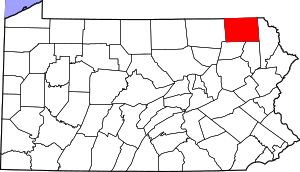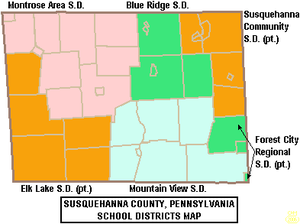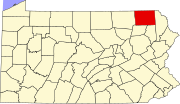
Wyoming County is a county in the Commonwealth of Pennsylvania. As of the 2020 census, the population was 26,069. Its county seat is Tunkhannock. It was created in 1842 from part of Luzerne County. The county is part of the Northeast Pennsylvania region of the state.
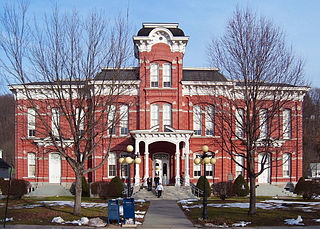
Wayne is a county in the Commonwealth of Pennsylvania. The county's population was 51,155 at the 2020 census. The county seat is the Borough of Honesdale. The county was formed from part of Northampton County on March 21, 1798, and was named for the Revolutionary War General Anthony Wayne. The county is part of the Northeast Pennsylvania region of the state.

Sullivan County is a county in the Commonwealth of Pennsylvania. As of the 2020 census, the population was 5,840, making it the second-least populous county in Pennsylvania. Its county seat is Laporte. The county was created on March 15, 1847, from part of Lycoming County and named for Major General John Sullivan. The county is part of the Northeast Pennsylvania region of the state.

Schuylkill County is a county in the Commonwealth of Pennsylvania. As of the 2020 census, the population was 143,049. The county seat is Pottsville. The county is part of the Northeast Pennsylvania region of the state.

Pike County is a county in the Commonwealth of Pennsylvania. As of the 2020 census, the population was 58,535. Its county seat is Milford. The county is part of the Northeast Pennsylvania region of the state.
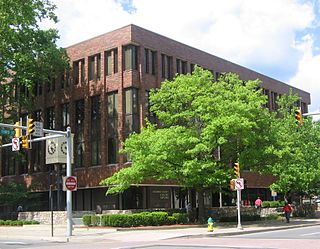
Lycoming County is a county in the Commonwealth of Pennsylvania. As of the 2020 census, the population was 114,188. Its county seat is Williamsport. The county is part of the Central Pennsylvania region of the state.

Luzerne County is a county in the Commonwealth of Pennsylvania. According to the United States Census Bureau, the county has a total area of 906 square miles (2,350 km2), of which 890 square miles (2,300 km2) is land and 16 square miles (41 km2) is water. It is Northeastern Pennsylvania's second-largest county by total area. As of the 2020 census, the population was 325,594, making it the most populous county in the northeastern part of the state. The county seat and most populous city is Wilkes-Barre. Other populous communities include Hazleton, Kingston, Nanticoke, and Pittston. Luzerne County is included in the Scranton–Wilkes-Barre–Hazleton Metropolitan Statistical Area, which has a total population of 555,426 as of 2017. The county is part of the Northeastern Pennsylvania region of the state.

Lackawanna County is a county in the Commonwealth of Pennsylvania. It is located in Northeastern Pennsylvania and had a population of 215,615 (2022). Its county seat and most populous city is Scranton. The county is part of the Northeast Pennsylvania region of the state.
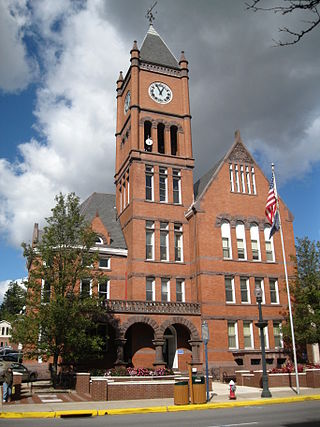
Columbia County is a county in the Commonwealth of Pennsylvania. It is located in Northeastern Pennsylvania. As of the 2020 census, the population was 64,727. Its county seat is Bloomsburg. The county was created on March 22, 1813, from part of Northumberland County. It was named Columbia, alluding to the United States and Christopher Columbus. The county is part of the Central Pennsylvania region of the state.

Carbon County is a county in the Commonwealth of Pennsylvania. As of the 2020 census, the population was 64,749. The county is part of the Northeast Pennsylvania region of the state.

Pittston Township is a township in Luzerne County, Pennsylvania. The population was 3,179 as of the 2020 census. The township is located within the Greater Pittston region. As of 2010, the total population of Greater Pittston was 48,020. The Wilkes-Barre/Scranton International Airport is located in Pittston Township.

Dimock Township is a township in Susquehanna County, Pennsylvania, United States. The population was 1,232 at the 2020 census. It is the home of former U.S. Congressman Chris Carney, a Democrat who represented Pennsylvania's 10th congressional district from 2007 to 2011. The school building for the Elk Lake School District is located near the village of Elk Lake in the township.

Great Bend Township is a township in Susquehanna County, Pennsylvania, United States. The population was 1,711 at the 2020 census. Children living in the township are served by the public schools in the Blue Ridge School District, including Blue Ridge High School.

Hallstead is a borough in Susquehanna County, Pennsylvania. The population was 1,179 at the 2020 census.

Pennsylvania Route 29 is a 118-mile-long (190 km) north–south state highway that runs through most of eastern Pennsylvania.
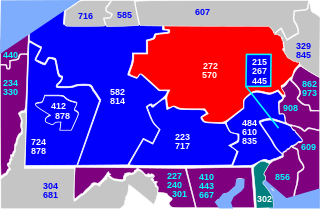
Area codes 570 and 272 are telephone area codes in the North American Numbering Plan (NANP) for the northeast quadrant of the U.S. state of Pennsylvania. The numbering plan area (NPA) includes the cities or towns of Scranton, Wilkes-Barre, Williamsport, Stroudsburg, East Stroudsburg, Pittston, Carbondale, Hazleton, Clarks Summit, Towanda, Bloomsburg, Sayre, Tunkhannock, Berwick, Milford, Montrose, Honesdale, Pocono Pines, Nanticoke, Tamaqua, Shavertown, Dallas, Mahanoy City, Sunbury, Jim Thorpe, and as far south as Pottsville and as far west as Lock Haven.

Pennsylvania Route 171 is a 40.17-mile-long (64.65 km) north–south state highway located in northeast Pennsylvania. The southern terminus of the route is at U.S. Route 6 Business in Carbondale. The northern terminus is officially at an intersection with US 11, 250 feet (76 m) to the west of Interstate 81 (I-81).

Pennsylvania Route 374 (PA 374) is a 17.7-mile-long (28.5 km) state highway located in Susquehanna County, Pennsylvania. The western terminus is at PA 92 in the community of Glenwood in Lenox Township. The eastern terminus is at PA 171 and PA 371 in the community of Herrick Center near Union Dale in Herrick Township. The route is a two-lane undivided road that passes through rural areas of farms and woods in southern Susquehanna County. PA 374 intersects PA 407 and Interstate 81 (I-81) in Lenox Township and forms a concurrency with PA 106 in Clifford Township.
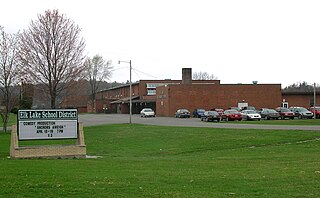
Elk Lake School District is a small, rural, K-12 public school district with its only building located on State Route 3019 in Dimock, Susquehanna County, Pennsylvania. It covers Auburn Township, Middletown Township, Rush Township, Dimock Township, and Springville Township in Susquehanna County, along with Meshoppen Borough and Meshoppen Township in Wyoming County. The Elk Lake School District encompasses approximately 197 square miles (510 km2). According to 2000 federal census data, Elk Lake School District serves a resident population of 7,735 people. In 2009, the district residents’ per capita income was $15,355, while the median family income was $38,385. In the Commonwealth, the median family income was $49,501 and the United States median family income was $49,445, in 2010. In 2006, the district students are 97% white, less than 1% Asian, less than 1% black and 2% Hispanic.

The Montrose Area School District is a small, rural public school district that is located in northwestern Susquehanna County, Pennsylvania. It serves the following municipalities: Montrose, Bridgewater Township, Franklin Township, Liberty Township, Jessup Township, Forest Lake Township, Silver Lake Township, Little Meadows, Choconut Township, Friendsville, and Middletown Township.

